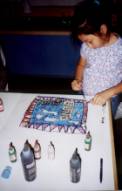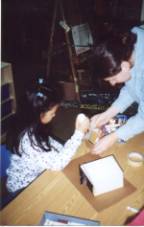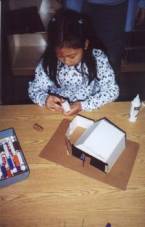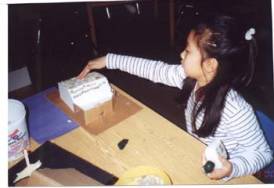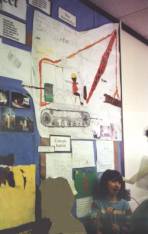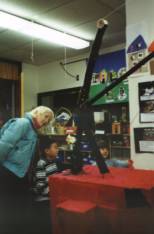
Phase 3: Sharing Results, Findings, and Understandings
The primary method of assessing what the children have learned is through the documentation of growth and progress. In a multi-age classroom there is a complexity of learning exhibited. Teachers were interested in children gaining an understanding of the "big ideas" as well as developing basic skills and knowledge in the content areas. Students came to appreciate the importance and uses of different types of buildings. They gained an awareness of the relationship between construction, buildings, and the environment. They acquired knowledge about the process, tools, and machines that are related to construction. They were exposed to many experts in fields of architecture, landscape architecture, mechanical and civil engineering.
Students developed in depth knowledge about areas that they studied. They categorized their understandings into four broad areas: definition of construction, construction machines, methods and materials, and the process of construction. They completed a second web (Student Construction Topic Web II).
With guidance from the teachers, the students planned what they would to do to tell the story of how and what they learned about construction. Groups of students worked on a model of the building at the construction site, a model of a crane, a model of a dump truck, stained glass windows, individual boxes & junk buildings, murals, posters, and speeches. In this phase, students negotiated and problem-solved as a daily ongoing experience to work out collectively what they knew.
What I Learned about Construction
|
Definition of Construction WJ: We have learned about construction of buildings and skyscrapers
and houses and we have learned about building and constructing. |
|
Building Machines AK: I learned that you call the crane's pulley a boom and I learned
that the boom holds a thing on top of it is called a pulley. |
|
Construction Methods and Materials SL: In the wall you have to put wood or metal. |
|
Construction Sequence and Time. MA: Buildings are built from the basement to the top. |
Products
Model of the Building at the Construction Site
After visiting the University of Illinois Communication Building Construction site, where students did observational drawings, counts, interviewed the site manager and took pictures, the students were asked to revisit their drawings, photos, and videos and make a three-dimensional representation of the building. Students worked collaboratively on this model. They started by making a blueprint of the building. They reported their progress at group meeting. At one point, in order to keep track of how much they still had to finish, they made a planning list.

Blueprint of the model of the building
|
List: Inside A Building Being Constructed NO: Wood |
They worked out a major problem of how to accommodate the number of people that wanted to help in a relatively small box (6x4x2) by working in shifts. CS and JP constructed a long handled paintbrush that would allow easier painting of the inside of the building.

Using a long-handled paintbrush
Children worked collaboratively to solve many problems while making the three-dimensional building. They figured out how to attach the scaffolding, the triangle roof and the pipes on the inside ceiling.
| HB: How are we going to put that triangle on the roof? See, there
it is. Look at the picture. SJ: Use tape. (They use tape) HB: It still falls down. JF: Let's take two pieces of little cardboard things. Like this. (Cuts cardboard. Several times she put it up behind the triangle for measurement only to cut some more) JF: See, I got it to stay up. HB: Good, let's tape it. |
Students shared their progress on making the representations at a large group meeting.
| NO: Me, JN, SJ, and CS were painting the building. And we were wearing
paint smocks. We were painting the scaffolding red. CM: Well, that's the color that it is supposed to be. JP: I was painting the scaffolding on the building. CS: We were taping the pipes. We were fixing the other pipes and putting tape over the other ones. Teacher: Why did you put the pipes on the ceiling? BG: Because I could see the pipes on the ceiling on the field trip. CO: You can see pipes on the ceiling of our back room. Teacher: Why are the pipes on the ceiling? CM: It brings water upstairs to the offices up there. Teacher: Can the people see the pipes? JP: No, it's under the floor. Teacher: Do you think we have pipes under our floor? (Children respond with many yes and no's.) NC: That would be a good sign-in question. |
|
Checking the photographs for details.
|
|
Working on the inside of the building.
|
Model of a Crane
From the beginning of the project, children were especially interested in cranes. This interest carried through the length of the project. They asked the site manager about cranes, researched on the Internet, and experimented with different materials to make a crane cable. Children worked hard problem solving because of the complexity in representing the crane's boom and crawler type wheels.
|
Crane Cab Conversation Teacher: You want me to cut a hole here? What happened when we cut a lot of holes in our construction site building? AK: One side is sort of leaning. AH: It caved in. We should only cut to here. AK: Cut it down here (further down than AH's line). AH: But it might break. Teacher: Let's see what happens. We'll cut it all the way. If it breaks we'll patch it. (Teacher cuts.) AH Pounds on it and it holds well. |
The children were pleased with their accomplishments because the model was large and impressive with a pulley and hook that really worked.

Constructing the boom of the crane
Model of a Dump Truck
Students were also interested in vehicles. A number of children had been involved in building a representation of an old-fashioned car as an independent study. They had observed dump trucks at the construction site. A group of children decided to make a representation of a dump truck. They problem solved through conversation and debate.
|
A conversation between JH, MA, and BG while making the dump truck. Teacher: - Your chose to work on the dump truck. Look at these boxes and show me which ones we could use to make the front cab part of the dump truck. BG: These two big ones to sit in MA: We can put them like this. JH: No, not like that. MA: WHY? Teacher: JH stand back and look at it. Now look at the picture of the dump truck. JH: Well, it's actually pretty good. Teacher: What can you add to it? JH: Windows and lights. BG: Wheels and a gas tank. Teacher: BG, What can we use to make the dump part? JH: I know something (Goes to the storeroom and pulls out some more boxes). This is the dump part. BG: We can use a string for this (The hydraulic lift). Teacher: So string can hold up the whole dump? BG: No it's wire. I know (He goes back to the storeroom and brings out two containers). Teacher: Look at the picture there is a smaller part and a… MA: Larger one. BG: (Notices he has a smaller container and a larger one) Look at this. Teacher: So when the truck dumps, this is the part that lets it move. How can we make this work? BG: I know. Look this smaller one goes inside the bigger one. Teacher: If it is all the way down how will we get it out? BG: Wait (Goes into the storeroom, and comes out with lids that he stuffs inside the larger container) The hydraulic lift works. |
|
Working on the dump truck
|
|
Putting the pieces together
|
Stained Glass Windows
Children had a number of questions about windows and in particular two children had questions about stained glass windows. NO asked the site manager a stained glass question, and researched in books to find out more about stained glass windows. She wanted to represent stained glass windows. The art student teacher showed her a three-step method to represent stained glass by using acetate, and special paints. She was very excited in reporting back to the group. Others joined her in making stain glass windows.
|
|
||
|
Representing a stained glass window
|
||
Individual Boxes & Junk Buildings
Each child constructed a building. They chose what kind of building they wanted to construct. They made a plan (blue print) and chose the number of walls and the size of the walls and roof. They chose the number of doors and windows and glued it to a foundation. They decided if they wanted special features and materials like wood, string, spackle, sand or rocks. Then they painted. This project took many days to complete.
|
AH gluing her model house together.
|
|
AH building an addition to her
original structure.
|
Collage Mural
Children chose collage materials to construct a building. These buildings were displayed. The children continued by making a collage of themselves. Both of these collage subjects were combined on a mural.
Poems, Stories, and Songs
The construction project inspired writing. They wrote and drew their personal memory stories about construction and they edited and published "Home-Adventure-Home Stories". A "Home-Adventure-Home Story" begins with the character at home, the character goes on an adventure and returns home. The children also wrote stories about cranes. Using their new understandings, they wrote poetry and a song to the tune of "I've Been Working on the Railroad."
The teachers read a number of construction poems to the students in whole group meetings. The teacher suggested a format for students to develop their own poems. Some followed a template and used their new construction vocabulary and knowledge. These poems were written during language and literacy time. They were displayed around the room for sharing day.
Poem Template
A, A
Mighty B
A
You C and D (like) an E
Mighty B A
Bulldozer, bulldozer
Mighty red bulldozer
You push and scoop
Mighty red bulldozer. CM
Crane, crane
Mighty blue crane
You big and crash
Mighty blue crane. KK
Backhoe, backhoe
Mighty yellow backhoe
You dig and dump.
Mighty big backhoe. NC
A crane, A crane
Noisy crane
As big as a dinosaur
Noisy crane. BG
Bulldozer, bulldozer
Mighty big bulldozer
You push away dirt
And make places like a mall
Mighty big bulldozer. JB
Drill machine, drill machine
Mighty big drill machine
You drill and drill
Mighty big drill machine. JN
Dump truck, dump truck
Mighty noisy dump truck
You carry and dump
Mighty noisy dump truck. SL
Tow-truck, tow-truck.
Mighty huge tow-truck
You carry and pile
Mighty huge tow-truck. JH
Raking-back, raking-back
Mighty green raking-back.
You boom and shake the earth like a Seismosaurus
Mighty green jaunty. AK
Crane, crane
Mighty long crane
You lift and roar
Mighty long crane. CS
Steam shovel, steam shovel
Mighty big. Steam shovel
You work and work like a bee.
Mighty big steam shovel. JP
Home Adventure Home
by AK
Once upon a time, there was a horse who lived in a red barn. The red barn had a black roof with no chimney, and a white cross on the door. The horse was a girl named Duchess. She was a horse bought from England to America. An American person dropped her off at the barn. She was brown with darker mane and tail, and black hooves.
One day when Duchess was gazing out of the barn window at the beautiful places around the barn, she saw one Monarch butterfly. She got distracted at the Monarch butterfly and ran out of the barn door. The Monarch butterfly flew away. Duchess was lost in the forest and she was scared. She roamed around in the forest trying to find her way home.
When she was walking, she froze. She saw a giant humongous big footprint on the ground. It was from a brown bear! Now, she was even more scared. Then she heard a soft growling through the woods. It was from the brown bear who left the footprints. The brown bear smelled Duchess, then he came out of the bushes and started running after her. Duchess ran as fast as she could to a tree. She stopped and jumped into the branches of the tree to get away from the brown bear. The brown bear could not smell her anymore for the leaves had covered her. The brown bear finally went away and Duchess came down from the branches.
Duchess felt fine so she started roaming around again. She roamed for two hours until she froze again for she saw the bear footprint again! This time no bears came but after one second, she heard another growling from one foot away. The bear came out of the bushes and looked at her. Duchess looked at him. Then something unusual happened. The bear walked away and growled one more time at her. The message of his growling meant for Duchess to follow him.
And so Duchess followed the brown bear and the brown bear lead her right to Duchess house!
The End
Construction Song
To the Tune of "I've Been Working on the Railroad"
|
I've been working on the construction
Someone will show the stained glass window, We're singing about construction, |
Display
Children listed all the displays that they wanted parents to see. During Project/Activity time, the atmosphere of the classroom was energized with students busy finishing displays of what they had learned. Children grouped themselves by areas of interest and talents. Their products represented the diversity of the group of children. They shared their stories, artwork, science experiments, and models. Daily, teachers asked students to evaluate and report the progress that they were making on their displays.
Some children made a poster of a crane. They used the overhead projector to enlarge a drawing out of a book (Tarsky, 1997) and they labeled the parts of the crane.
The teachers read a variety of versions related to the story, "The Three Little Pigs." Children compared and contrasted the characters, illustrations, plot sequence, ending, and moral of the story. They displayed their comparisons for the parents (Three Little Pig Stories: Similarities and Differences).
Children became skillful at integrating new vocabulary words into their conversations about construction. They wanted to make a list of all of the new words that they had learned to share with their parents.
New Construction Vocabulary
| Apartment Ax hammer Ball peen hammer Back hoe Back hoe excavator Beams Boom Bulldozer Buttress Cab Carpenter pencil Caution days Caution tape Cement mixer Cement truck Claw hammer Columns Concrete Cone Construction Crawler tracks Cube Cylinder Drill gun Drywall Duct tape Dumper/Carrier Dump truck Excavator Facility Flat surfaces Fork lift Front end loader Garbage truck Gasoline shovels Geometry Grader Hard hats Hydro lift Jackhammer |
Measuring tapes Molding Nail gun Nail sizes (all) Plasterboard Planks Pliers Pulleys Rectangular prism Rings Rubber hammer Scaffolding Screw Screw gun Screwdriver Shingle Shutters Skeleton Skyscraper Sledge hammer Solid Spackling Sphere Spiral Sponge Square pyramid Stained glass Steam roller Steam shovel Tar Texture Tiles Tool belt Tower cranes Triangular prism Triangular pyramid Truss Walkie-talkie Windows Wire ropes Workers |
Share Day
In teams of two students chose the display that they would like to explain.
They worked together on a speech. Then they practiced many times. They
used a planning sheet with three prompts to help them organize what they
would explain to their parents.
1. This is
what we did.
2. This is
how we did it.
3. Notice
this: What's special about our display?

Writing their speech for parents
When the big day arrived, after singing the song, children placed themselves around the room, giving their speech over and over to groups of parents that came by. It was a huge success.
|
Explaining how the crane works
|
|
Sharing their model of the crane
|
|
|
 |
||
|
STUDYING
CONSTRUCTION |
EXPLORING
COMMUNICATION |
© 2001. University
Primary School. Department of
Special Education. University of Illinois.
All rights reserved. Credits.










